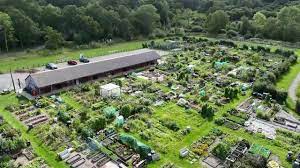
The study that the article is based on comes from the university of Michigan, and is frankly badly, badly made. It is the quintessential study, where this is the answer, now how do we get there, sort of study.
So, what did they do? Well, they put gardens into 3 different categories
- Backyard gardens – single occupancy
- communal gardens (like the above)
- Urban farms
Your backyard garden has about as small a carbon footprint as it is possible to have, it is possible that fruit or veg from here actually has zero carbon footprint. Community gardens can be a bit different – you have a small area, so you might use more compost or fertilizer, and it is possibly further from where you live, so you might drive to it. However, this kind of place also has a low carbon footprint.
It is essentially just the Urban farms which are a problem here: growlights and watering and temperature controls all add up to large quantities of energy.
This video shows this is an easy way to understand.
Do not be put off! If you have an allotment or a vegetable patch in your garden, this is almost completely carbon free food, it does bring down your carbon footprint.
It is unfortunately the kind of study you can find in a newspaper like the Telegraph; I do not think it would be a surprise for any readers to hear, that this is not the place readers go to find out about the new scientific studies of this kind.
